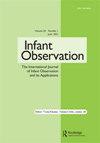Current preoccupations in infant observation
Q4 Psychology
引用次数: 0
Abstract
In this issue, Margaret Rustin’s paper, ‘Where are we now? Reflections on infant observation then and now’ (Rustin, 2022), reviews developments since the midto late 1960s when she herself began her training. She begins, naturally, with the fact that Esther Bick began infant observation, for child psychotherapy trainees at the Tavistock Clinic, 74 years ago in 1948 (interestingly the same year that the British National Health Service began). At the present time, in 2022, I have in mind two major themes in terms of developments in infant observation. One of them still predominates in articles submitted to Infant Observation; the impact of the Covid pandemic and the lockdowns which were imposed from early 2020 until 2021. The other theme, which I hope, over time, will be discussed in submissions to the journal, is the inclusion of thinking about diversity and difference in infant observation. This subject will be the theme of an international conference for infant and other observation teachers at the Tavistock Clinic in the summer of 2023. The impact of the pandemic and the periods of lockdown continue to appear in various ways in accounts of infant observations which took place during the past two years. Some began ‘in person’ and moved to online, using video, while other started online. One account of two observations published in our last issue described the observations of Iva Ajder and Lumley (2021) which had been fascinating ‘in person’ observations of two interesting babies and their mothers, but which had to finish after a few months online – a painful struggle for both the observers and the families and babies. Maria Pozzi Monzo, in this edition, offers an extremely interesting account of ‘making the best of a bad job’, in her article about continuing parent infant psychotherapy online during the lockdown in the UK. Her detailed clinical material and candid comments bring to life the difficulties of trying to work clinically with mothers and their small children on screen, and the worthwhile perseverance which she brought in offering sessions over longer time periods of time in order to be effective. All the cases which she reports demonstrate how important it was to be clinically flexible in such difficult times. An news article, which is an account from two infant observation teachers from Russia, Tayana Alexandrova andOlga Papsueva, published in this issue describes their struggles to keep something valued and valuable going during the pandemic in their country. Their account also draws our attention to a few glimpses of cultural difference. It seems that some observations are set up entirely by telephone before the observation itself begins. This is certainly unusual in the UK tradition. The article also provides glimpses of such characteristics of Russian family life such as the way the observer is greeted on arrival at the family’s apartment, which to western European eyes appears extremely formal. The authors state that Russian families are generally receptive to the ideaofweekly observation. It would be very interesting to understand more about the positive responses. The article also describes the way observed Russian families responded to the lockdown of the pandemic. There is a stark contrast in the authors’ minds between in-person contact and video linking; the video link seems, in their minds to be almost unbearable and, in the当前对婴儿观察的关注
在本期的Margaret Rustin的论文中,“我们现在在哪里?”?对当时和现在婴儿观察的反思”(Rustin,2022),回顾了自20世纪60年代中后期她自己开始训练以来的发展。她很自然地从埃丝特·比克(Esther Bick)于74年前的1948年开始为塔维斯托克诊所(Tavistock Clinic)的儿童心理治疗受训人员进行婴儿观察开始(有趣的是,这一年也是英国国家卫生服务局(British National Health Service)成立的同一年)。目前,在2022年,我想到了婴儿观察发展的两个主要主题。在提交给《婴儿观察》的文章中,其中一篇仍然占主导地位;新冠肺炎疫情的影响以及从2020年初到2021年实施的封锁。另一个主题,我希望随着时间的推移,将在提交给该杂志的文章中进行讨论,那就是在婴儿观察中纳入对多样性和差异性的思考。这一主题将成为2023年夏天在塔维斯托克诊所举行的婴儿和其他观察教师国际会议的主题。在过去两年对婴儿的观察中,疫情和封锁期的影响继续以各种方式出现。一些人从“面对面”开始,转而使用视频上网,而另一些人则开始上网。我们上一期发表的一篇关于两项观察结果的报道描述了Iva Ajder和Lumley(2021)的观察结果,这两项观察对两个有趣的婴儿及其母亲进行了引人入胜的“面对面”观察,但在网上几个月后不得不结束——这对观察者、家庭和婴儿来说都是一场痛苦的斗争。玛丽亚·波齐·蒙佐(Maria Pozzi Monzo,以及她为有效提供更长时间的课程所带来的值得坚持的精神。她报告的所有病例都表明,在如此困难的时期保持临床灵活性是多么重要。本期发表的一篇新闻文章是来自俄罗斯的两位婴儿观察老师Tayana Alexandrova和Olga Papsueva的报道,描述了他们在疫情期间为保持自己国家的价值和价值所做的努力。他们的叙述也让我们注意到一些文化差异的一瞥。一些观察似乎完全是在观察开始之前通过电话进行的。这在英国的传统中当然是不寻常的。这篇文章还简要介绍了俄罗斯家庭生活的这些特点,比如观察者到达家庭公寓时受到的欢迎方式,在西欧人看来,这似乎非常正式。作者表示,俄罗斯家庭普遍接受这一观点。如果能更多地了解积极的反应,那将是非常有趣的。文章还描述了观察到的俄罗斯家庭对疫情封锁的反应。在作者的脑海中,面对面接触和视频链接形成了鲜明的对比;在他们看来,视频链接几乎令人难以忍受
本文章由计算机程序翻译,如有差异,请以英文原文为准。
求助全文
约1分钟内获得全文
求助全文

 求助内容:
求助内容: 应助结果提醒方式:
应助结果提醒方式:


